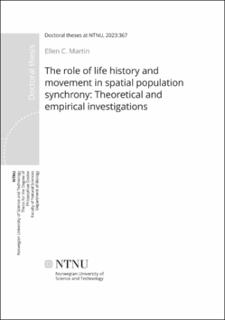| dc.contributor.advisor | Lee, Aline | |
| dc.contributor.advisor | Hansen, Brage Bremset | |
| dc.contributor.advisor | Herfindal, Ivar | |
| dc.contributor.author | Martin, Ellen Claire | |
| dc.date.accessioned | 2023-12-19T12:47:14Z | |
| dc.date.available | 2023-12-19T12:47:14Z | |
| dc.date.issued | 2023 | |
| dc.identifier.issn | 2703-8084 | |
| dc.identifier.uri | https://hdl.handle.net/11250/3108205 | |
| dc.description.abstract | Spatial population synchrony, the correlated fluctuation of population abundances in different places, is common between populations of the same species and an important predictor of extinction risk. Spatially separated populations are expected to have the same synchrony in their dynamics as that in their environment. However, species have unique traits (i.e., life history traits) that influence what environments they are exposed to and how sensitive their population dynamics are to these environments. In this thesis, I investigate a suite of life history traits which dictate 1) the environments that different populations are exposed to via migration or dispersal and/or 2) how population dynamics are expected to respond to these environments based on life history traits linked to sensitivity of survival and fecundity, such as position on the fast-slow life history continuum.
We find that the degree of synchronization in population abundances depends on a variety of different components of migration, such as how populations migrate in relation to neighboring populations on the breeding ground, and how autocorrelated the environment on the nonbreeding ground is. We also show through simulation that variation in species’ spatial population synchrony depends on the presence of dispersal and demographic stochasticity in a population, and how strong of an effect environmental noise has on individual vital rates. Differences between life history traits do not follow a simple pattern and are not always going to be the same, but rather will depend on which parameter environmental noise is acting, and the strength of this environmental noise. We link these findings to empirical examples and show e.g., that species with shorter generation times tend to be more synchronized than species with longer generation times, and short-distance migrants are more synchronized than long-distance migrants and resident species. By constructing population models and using available long-term monitoring datasets, we demonstrate the importance of considering species’ life history traits and the resulting different levels of sensitivity to the environment when determining a metapopulation’s susceptibility to environmental variability. | en_US |
| dc.language.iso | eng | en_US |
| dc.publisher | NTNU | en_US |
| dc.relation.ispartofseries | Doctoral theses at NTNU;2023:367 | |
| dc.relation.haspart | Paper 1: Martin, Ellen Claire; Hansen, Brage Bremset; Herfindal, Ivar; Lee, Aline Magdalena. The role of seasonal migration in spatial population synchrony. Ecology 2023 s. This is an open access article under the terms of the Creative Commons Attribution-NonCommercial License. Available at: http://dx.doi.org/10.1002/ecy.4158 | en_US |
| dc.relation.haspart | Paper 2: Martin, Ellen Claire; Herfindal, Ivar; Hansen, Brage Bremset; Lee, Aline Magdalena. Spatial population synchrony depends on relative impacts of environmental noise on different vital rates. This paper will be submitted for publication and is therefore not included. This paper will be submitted for publication and is therefore not included. | en_US |
| dc.relation.haspart | Paper 3: Martin, Ellen Claire; Hansen, Brage Bremset; Lee, Aline Magdalena; Herfindal, Ivar. Generation time and seasonal migration explain variation in spatial population synchrony across European bird species. Journal of Animal Ecology 2023 s. 1-15. This is an open access article under the terms of the Creative Commons Attribution License CC BY. Available at: http://dx.doi.org/10.1111/1365-2656.13983 | en_US |
| dc.relation.haspart | Paper 4: Martin, Ellen Claire; Hansen, Brage Bremset; Lee, Aline Magdalena; Herfindal, Ivar. How do life history traits influence the environment’s effect on population synchrony? Insights from European birds and insects. Preprint available at bioRxiv: https://doi.org/10.1101/2023.09.08.556676 | en_US |
| dc.title | The role of life history and movement in spatial population synchrony: Theoretical and empirical investigations | en_US |
| dc.type | Doctoral thesis | en_US |
| dc.subject.nsi | VDP::Matematikk og Naturvitenskap: 400 | en_US |

